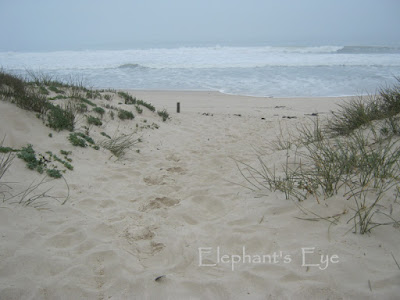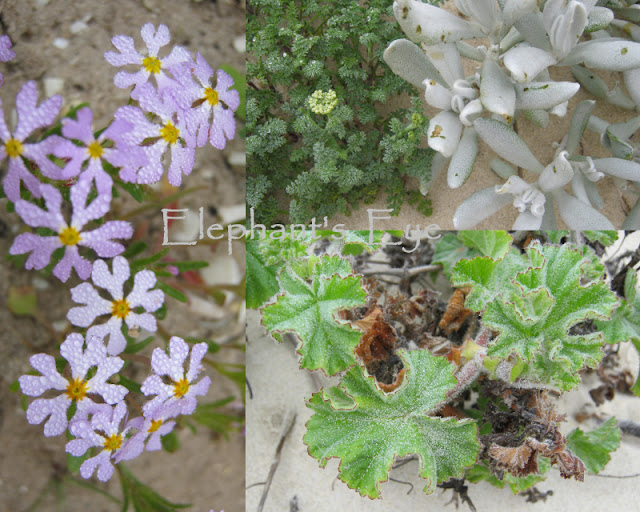Winter day at Rocher Pan
by Diana
Studer
- gardening for biodiversity
He prefers to choose his days out in brilliant
sparkling sunshine, his Swiss roots showing. August 2013 I revelled in a
grey winter day, low cloud, heavy sea fog – a world of our own enclosed in grey
and damp. We went to CapeNature’s RocherPan Nature
Reserve, counting on birds as the pan had filled with winter rain.
We returned in November 2013 to sun and
Cape fur seals.
We stopped first at the new office, in a fine eco-building. With solar panels and composting toilets (not much water, and no waterborne sewage lines available!) Got our permit with our WildCard, looked with interest at the shiny new eco-cottages. We drove along the road to the main gate for the reserve.
From the bird hide we looked across the water. Flamingoes,
gulls, coots. Then suddenly we noticed a Greater Flamingo patrolling slowly
past the bird hide. Those electric pink legs are shocking, especially on a
bleak grey day.
In the reeds below the hide was a pair of Red-knobbed Coot.
‘When breeding, they are inclined to become very pugnacious. They will chase
other birds, almost running along the surface of the water’ – from Joy
Frandsen’s Birds of the South Western Cape. After he’d seen off the intruder,
these two settled quietly back to their lunch.
From across the pan we looked back to the office and
the eco-cottages
(click Accommodation). Closed combustion fire place. Waterless toilet. Each
cottage has a private deck looking over the pan and the birds. We stayed here in the spring wildflower season September 2016. All 4 were then occupied, so we couldn’t peek in. Four more
cottages were added.
From the pan, where we parked the car, we hiked up over the
dune. Then down to the sea. A whole long lost lonely desolate sweep of glorious
beach. We saw no life beyond the birds.
Who left their tracks between the wind carved ridges on the
dry sand above the waves?
If I were trying to garden on a salty windswept dune, even
on this winter’s day there was promise. The little purple flowers have the
common name of drumsticks – for the strangely shaped petals. Zaluzianskya villosa is in the Schrophulariaceae with northern Antirrhinum, Digitalis and Penstemon,
and South Africa’s Diascia, Nemesia and Halleria.
The Pelargonium grows happily tucked close to the sand beneath
the wind, velvety leaves gratefully slurping up the sea fog. There’s texture
and colour in foliage. Side by side in nature are two unknowns. Dune celery?
with a random yellow flower, near grey-bloomed succulent leaves.
He collected cuttlefish for Spirulino, our
flightless sparrow. We tucked the cuttlefish between the bars of his cage,
and he graciously shared with our garden birds.
I was fascinated by the long line, as the breaker slowly
built and rose, then curled and fell. The next town is Eland’s Bay famous among surfers.
And sadly, always our contempt for nature, expressed in
discarded plastic garbage. We saw a cormorant trailing a piece of rope,
entangled on his leg. Walking the tide line, there are treasures to be seen. A
perfect pair of mussel shells, midnight blue with some tiny barnacles crusted
on. Mermaid’s purse is the egg case of a shark.
I invite you to join us at Elephant's Eye on False Bay.
Please subscribe as you prefer
via Feedly,
or Bloglovin,
Pictures by Jurg and Diana Studer
(If you mouse over teal blue text, it turns seaweed red.
Those are my links.
To read or leave comments, either click the word Comments
below,
or click this post's title. If you are in email or a Reader,
first click thru to the blog)











Wow - the Zaluzianskya is amazing. I've never seen it before.
ReplyDeleteI wonder if Rocher Pan is dependent on rain water - and if so, if the recent drought affected the birdlife population negatively? Hopefully not.
(The flowers are small, but so elaborately shaped. Common name is drumsticks)
DeleteThe pan is seasonal - but I hope for flowers ... and birds, in September.
What a wonderful place to visit! It's almost impossible to find a beach with more birds than people here (not to speak of birds as colorful as flamingos). Sadly, the debris left by people seems to be everywhere. I enjoyed the story of your Spirulino too.
ReplyDeleteDays ago we were walking in Swiss mountains - shocked by hordes of people! Glad to be back to enjoying our quiet places at home.
DeleteIt's heartening and sometimes disappointing what one finds on the beach. Wildflowers on the dunes--now that's lovely! It sounds like September will be a perfect time for your return visit. :)
ReplyDeleteBeautiful atmospheric post. I love the subtle colours of the sand and sky and even the flowers on the dunes.
ReplyDeleteIt's such a shame that plastic gets everywhere. I much prefer to find a mermaid's purse!
Best wishes :)
The Path to the sea from Rocher Pan, looks so like the area which takes you towards Balmedie beach just North of Aberdeen. Must be amazing to see a Flamingo, well I have seen one, but only on the television. Have I told you, it looks like we are returning to Bonnie Scotland, new house will be ready to move into mid January.
ReplyDeleteWow - lots of upheaval, but happier once you have settled again!
DeleteSo sad to read that Spirulino died. Was it old age?
ReplyDeleteIt was a sad story - but he had a few good years.
DeleteIt's easy to see why you are returning to Rocher Pan. "A whole long lost lonely desolate sweep of glorious beach." Wow! P. x
ReplyDeleteIt looks like a wonderfully calming place. Just looking at your photos slowed my heart rate :-)! -Jean
ReplyDelete